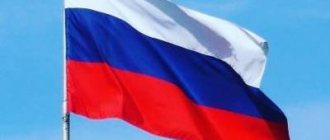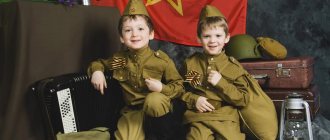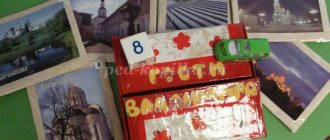Topics on patriotic education of children
- “Our Motherland is Russia.”
- “I love you, Russia! Russia Day".
- “What does it mean to love your homeland?”
- “The flag and coat of arms are state symbols of Russia.”
- “Beloved land, native land!”
- "Our famous fellow countrymen."
- "Sights of our city."
- “We talk about our family.”
- “Why are we proud of our village?”
- "Life and folk crafts in Ancient Rus'."
Summary of a lesson on civic-patriotic education of children in the preparatory group. Russia
Lesson in kindergarten.
Preparatory group of preschool educational institution. Traveling around Russia Purpose : To develop in children a sense of patriotism and love for their Motherland. Objectives: To summarize and systematize children’s knowledge about Russia, to form a respectful attitude towards the state symbols of Russia - the flag, anthem, coat of arms and their distinctive features; develop cognitive interest in the history of the state; to cultivate patriotic feelings, love for the Motherland, and respect for the symbols of our country. Materials : Images of coats of arms and flags, crossword puzzle, visual teaching aids, exhibition of drawings dedicated to the Great Patriotic War. Preliminary work : Conversations about Russian symbols;
reading poems, proverbs and sayings about the Motherland; looking at photographs of cities and rivers; conversations, viewing illustrations and performing works based on folk arts and crafts. Progress of the lesson
Children read poems with a letter from an alien: “Hello guys!
I'm from the planet Mars! I am a Martian! I have been observing your planet for a long time. There are many different countries on planet Earth. And I would like to know what country you live in. Tell us everything you know about your country.” The children invite the Martian to go on a journey. Educator: There are many different countries on the planet, but our country is the largest. What is it called? Children: Russia. Educator : What is our Russia like? Children: Big, beloved, beautiful, huge, rich, strong. Educator: Russia is our Motherland. Guys, explain how you understand what “Motherland” is? Children: Motherland is the place where we were born and live. Each person has one homeland. Educator: Guys, who knows a poem about the Motherland? Poem: The Great Land, the Beloved Land, Where we were born and live, We are the bright Motherland, We are the sweet Motherland, We call our Motherland Educator: The Russian people have composed many proverbs and sayings about the Motherland. Remember them. (To live - to serve the Motherland. The Motherland teaches - the Motherland helps out. He who works hard for the Motherland is a true hero, etc.) Educator: What do these proverbs teach. Children: Kindness, love for the Motherland, the ability to defend it. – All these proverbs teach us kindness, love for the Motherland, and the ability to defend it from enemies. Now let's come to the map. – No country in the world has such a huge territory as Russia. Look at the map. (The teacher shows the children a map of Russia.) This is how much space the territory of Russia occupies. When people go to bed at one end of our country, morning begins at the other. It may be snowing at one end of our country, but the sun may be blazing hot at the other. To get from one end to the other, you need to travel for a week by train, and fly for a day by plane. Educator: How many days are there in a week? What are the days of the week? What are the parts of the day? - Guys, what can you travel on? (By plane, bus, etc.) Educator: I suggest you travel by train. Let's go. We take our seats in the carriage. (The music “Steam Locomotive” plays.) Educator : The station is called “State” Educator: Name what cities in Russia you know. - Name the capital of Russia (Moscow.) - Who will tell a poem about Moscow? Poem: Moscow is Red Square, Moscow is the Kremlin towers, Moscow is the heart of Russia, Which loves you Educator : The President of our country is...? (V.V. Putin) – Name the state symbols of Russia. (Coat of arms, flag, anthem.) - Find the flag of our country among others. (Images of flags are laid out, children choose the Russian flag from those offered.) - Well done! Who will recite a poem about the flag? Poem: White color - birch tree, Blue color of the sky, Red stripe - Sunrise. Educator: What versions of the colors of the Russian flag do you know? (This is the unity of the sea, earth and sky. This is the commonwealth of three Slavic outfits: white - faith, purity; blue - sky, nobility, loyalty; red - heroism, courage, courage. This is faith, hope, love) Educator : Now find coat of arms of our country. (Images are laid out, children choose the coat of arms of Russia from those proposed.) - Who knows a poem about the coat of arms? Poem: Majestic Russia has a double-headed eagle on its coat of arms, So that He can immediately look to the West, to the East, Strong, wise and proud. He is Russia's free spirit. Educator: Who is depicted on the coat of arms? (Double-headed eagle. Eagle is a symbol of the sun, heavenly power, fire and immortality). - Why does he have two heads? What are they holding in their paws? (Rod and orb. Rod - serves as symbols of power, honorable position. Power - state.) In ancient times, crowns, scepter and orb served as symbols of royal power. Today they remind us of the historical past of our Motherland. -What's on the eagle's chest? (shield). — Who is depicted on the shield? (rider on a horse). - What color is the horse? — What color is the rider’s cloak? — What color is the shield? What do these three colors remind you of: white, blue, red. - What is the name of the rider? He has long been revered in Rus' as the patron saint of warriors, defender of the Fatherland! — What is in the hands of St. George the Victorious? - Why does he need it? The black serpent symbolizes evil, and the brave warrior St. George the Victorious defeats the evil serpent. Good conquers evil! So our coat of arms symbolizes beauty and justice, the victory of good over evil! Educator: What is the anthem? (The anthem is the main song of the country. The anthem is listened to while standing.) - On what occasions is the anthem performed? Children sing the anthem. — The national anthem is also a state symbol. When is the national anthem performed? (Children give examples). — The Russian anthem is very beautiful and majestic. The author of the verses of the anthem is S. Mikhalkov, the music was written by A. Alexandrova. —What is the anthem dedicated to? (Children's suggestions). — The anthem is dedicated to our country, its endless expanses, wonderful brave people, great history, the anthem speaks about the past and future of the country, about the ardent love of citizens for their Motherland. Every citizen of Russia should know the words of the anthem. Educator: Which tree is a symbol of Russia? (birch) - Well, it’s time for us to move on. Our train is leaving. Has everyone taken their seats? Go. We arrived at the “Folk Craft” station Educator: Has Russia always been famous for its craftsmen? Who knows a poem about Russian masters? Poem: Russia was famous for its miracles - for its craftsmen, who turned wood and clay into a fairy tale. They created beauty with paints and brushes, and taught the young people their art. Educator: I suggest you remember the products of decorative and applied art of Russian masters. Guess the riddles. 1. Multi-colored girlfriends Love to hide in each other. What is this? (Matryoshka doll.) - Of course, this is a matryoshka doll familiar to us all. Here she is! (The teacher shows the children a matryoshka doll.) - Next riddle. 2. This painting is simply a miracle, all the dishes are blue. Painting with a blue curl beckons with Russian cornflower. (Gzhel.) Educator: That's right, guys. Look how beautiful it is. 3. Golden grass grew on the spoon, and a red flower blossomed on the bowl. (Khokhloma.) 4. All toys are not simple, But the magically painted ones are Snow-white, like birch trees, Circles, squares. Stripes. (Dymkovo toy.) 5. A kind master made a fairy tale, The animals in the fairy tale come to life, Bears, hares, beaters - Wooden toys. (Bogorodskaya toy.) D/game “Collect the word” (Russia, Moscow, coat of arms, flag, anthem, birch, president, earth, Motherland, power, planet, Mars) - Our journey continues. Have you taken your seats? Go. The station is called “Istoricheskaya”. Guys, I told you that there were many kings in Rus', and today I’ll tell you about a king who did a lot for Russia. This is Tsar Peter the Great (shows a portrait). Only one who was born into the royal family could become a tsar in Russia. Peter the Great's father died early; he was raised by his mother. Little Peter was very smart, healthy and brave. He really wanted to study. The teachers did not have time to answer his questions. And in his free time he loved to play soldiers. The boy Peter grew up, and the boys from the “amusing army” grew up with him. And when Peter grew up and became king, this “amusing army” turned into the best Preobrazhensky and Semenovsky regiments. At the time when Tsar Peter the Great came to power, Russia was a poor country. And in other countries people lived better. There were many factories, factories, and schools where children could study. Peter the Great wanted to turn Russia into a strong state. And he began to learn from foreigners. First of all, the king decided to create his own fleet. That's when he goes abroad to learn how to build ships. Peter the Great worked as a shipbuilder, a carpenter, and a blacksmith. He mastered 15 craft professions. It was very difficult to work because the tools were not the same as they are now. There were no machines at all, and we had to work manually. When Peter the Great returned to Russia, he immediately began building a fleet. Peter chose Voronezh as the cradle of the Russian fleet. The city stood on the banks of the river. Voronezh, not far from the Don. In the surrounding area there were oak and pine trees, which served as material for the construction of ships. Lipetsk iron ore lay nearby, from which cannons and other weapons could be smelted. He created the first Russian fleet, which later became the strongest in Europe. — Do you want to know what else new appeared in our country while Tsar Peter reigned? Much that Peter the Great did in Russia was the first time • the new year began to begin on the first of January, and previously it began in September; • in Russia they began to decorate a New Year tree in every house; • newspapers and magazines began to be published for the first time; • all children, both rich and poor, began to study in schools; • Peter the Great brought potatoes to Russia; Russian people had never tried them before. Let's make the coat of arms of our group. Our journey through Russia has ended. We remembered a lot, learned a lot.
We recommend watching:
GCD summary on the topic: Winter for children of the preparatory group GCD in the preparatory group. Symbols of Russia - coat of arms, flag Lesson in the preparatory group of the kindergarten on the topic: State symbols of Russia Abstract of OOD in the preparatory group of the kindergarten "Our Motherland - Russia"
Similar articles:
Conversation about the Constitution for older preschoolers
Conversation about the President of Russia in the senior group
Thematic conversation for children of the senior preparatory group “Commanders and Heroes”
Conversation for children 5-8 years old. Russia is proud of them
Summary of the lesson “Take care of nature” in the preparatory group
The tasks of patriotic education of children in preschool educational institutions
The tasks of patriotic education in preschool educational institutions are quite multifaceted. They expand and become more complex as preschoolers grow up, their thinking develops, as well as the gradual formation of the correct attitude towards the surrounding reality, relatives and strangers, and moral feelings.
Objectives of moral and patriotic education in kindergarten:
- To instill in children a love for the Motherland - their native country, its historical milestones, cultural values and traditions.
- To form an idea of the main symbols of Russia: the State Emblem, the State Anthem, the State Flag; teach to understand the meaning of the main elements of state symbols.
- Gradually expand the knowledge of preschoolers about Moscow - the main city of the Russian Federation, about the main attractions and memorable places of the capital.
- Enrich knowledge about the small homeland - the native land: about the origin and meaning of the name of the native city / village / town, about its beautiful corners and attractions, about places of military glory, about nature and people.
- Instill socially useful work skills; to form an idea of work as an important spiritual value for every person; Encourage children's desire to be useful and help other people.
- Cultivate respect for parents and other relatives, awaken interest in family traditions and moral values, family history.
- To introduce the peculiarities of national culture and traditions based on works of fiction and art, folklore, and the work of folk craftsmen.
- To form in preschoolers an understanding of the main national holidays.
- Talk about the Russian army, about the soldiers guarding the Motherland, about military professions (pilots, border guards, tank crews, sailors), about military equipment.
- To cultivate respect for the defenders of the Fatherland, for the memory of the soldiers who died for the Motherland.
- Develop civic-patriotic feelings, interest in events taking place in the country, and historically significant dates.
- To form in pupils a sense of pride for the successes of their Fatherland, for its power, natural resources; to form an understanding of the importance of work for the benefit of the Motherland.
- Instill respect for the people who glorified Russia: military heroes, cosmonauts, scientists, writers, artists.
- International education. Formation in preschoolers of interest and friendliness towards people living in other countries.
The tasks of patriotic education in kindergarten are solved comprehensively, taking into account the age characteristics of preschoolers, in a fun way that awakens interest and curiosity. The methods of moral and patriotic education in preschool educational institutions are diverse: verbal, playful, practical, visual.
Means of developing patriotic feelings in children are fiction, music, visual arts, excursions around their hometown/town/village, exciting games, creativity, feasible joint work, preparation for the holidays.




